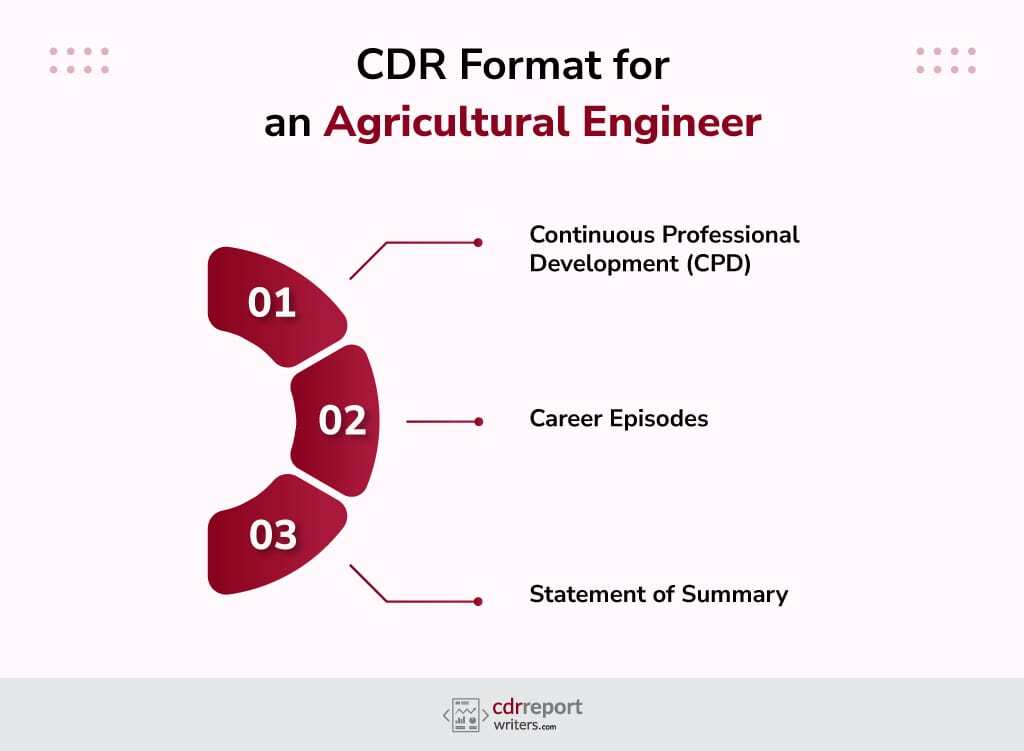
Perfect CDR for an Agricultural Engineer to Apply for PR in Australia
Agricultural engineers develop and plan the engineering for an agricultural project, generally in collaboration with an agriculturist who is more knowledgeable in farming and agricultural science. An agricultural engineer is a professional engineer with a background in agriculture.
Agricultural engineering is the study and application of engineering science and design principles to agriculture, combining the disciplines of mechanical, civil, electrical, food science, environmental, software, and chemical engineering to improve the efficiency of farms and agribusiness enterprises and to ensure the sustainability of natural and renewable resources. You may need to register or get a license.
To stay in Australia and New Zealand as an agricultural engineer, you need a level of expertise equivalent to a bachelor’s degree or higher qualification. In some cases, in addition to the official qualification (ANZSCO Skill Level 1), appropriate experience and on-the-job training may be necessary.
Agricultural Engineers can apply for three occupational categories recognized by EA. You can practice Agricultural Engineering in Australia as a Professional Engineer, Engineering Associate, or Engineering Technologist.
Australia is one of the most developed countries, and engineering experts like it for its vast diversity, growth, infrastructure, elegance, and way of life. There is no better place to pursue a career as an Agricultural Engineer than in Australia, the benefits of which get attributed to the country’s rising economy and infrastructure.
If you want to work as an Agricultural engineer in Australia, you must go through Engineers Australia’s migration skills assessment. You must submit an excellent CDR report for Agricultural Engineer(233912).
CDR Format for an Agricultural Engineer
The CDR comprises three sections: the Continuing Professional Development (CPD) list, the Career Episodes (CEs), and the Summary Statement. Each section demonstrates an applicant’s competency and suitability for PR in Australia.

1. Continuous Professional Development (CPD)
Continuing professional development (CPD) means remaining current with engineering innovations after you finish your undergraduate study. All acceptable CPD must get included in your CDR report. This CPD must get supplied as a list, with the title, time, period, venue, and place all included. On an A4 sheet, CPD gets written.
The CPD list demonstrates an applicant’s commitment to professional growth and development. It should include details of any relevant courses, conferences, workshops, or training programs attended by the applicant. Agricultural engineers should focus on CPD activities related to agricultural engineering, environmental management, and sustainable farming practices.
2. Career Episodes
Your engineering qualifications and employment experience get described in the career episodes section. Each episode of your professional life should be distinct and focus on a specific time or component of your technical job. The utilization of engineering knowledge and abilities in the chosen career must get shown in a Career episode.
Engineers Australia asks that your broadcast episodes be written in your own words and meet their specifications. Please explain what you did and why, to put it another way. Please explain how you achieved it, with a focus on your contribution. The length of each description should be between 1000 and 2500 words.
Career Episodes offer an opportunity for agricultural engineers to provide detailed accounts of their engineering projects and experiences. Selecting projects highlighting the applicant’s skills and demonstrating their ability to apply engineering principles to real-world scenarios is essential.
Engineers Australia requires three Career Episodes, and each episode should showcase a specific aspect of the engineer’s work. For an agricultural engineer, the following topics could get considered for the Career Episodes:
i. Developing and implementing sustainable irrigation systems to optimize water usage and improve crop yields.
ii. Design and management of precision farming techniques for increased efficiency and productivity in agricultural practices.
iii. Developing and implementing soil and nutrient management strategies to improve soil health and crop production.
In each Career Episode, it is vital to clearly describe the engineering tasks undertaken, the techniques and methodologies employed, and the outcomes achieved. Additionally, engineers should highlight their roles, responsibilities, and leadership skills during the projects.
Agricultural Engineer Career Episode Report Sample – 1
“Assessment of Different Rice Milling Machines” – 2405 Words
Agricultural Engineer Career Episode Report Sample – 2
“Preparing Strategies of Farm Mechanization Project” – 2160 Words
Agricultural Engineer Career Episode Report Sample – 3
“Adaptation of Dehusking Machines” – 2070 Words
Learn More: Australian Visa Options for Qualified Electrical Engineers 🧑🏽✈️🏆
3. Statement of Summary
A career episode depicts your engineering participation in a specific project, whereas a summary statement summarises your impressions and engagement. Go over your career episodes again after finishing them to ensure you have covered all the needed competencies for the position.
The Summary Statement establishes a link between the competency pieces and the paragraph in your career episode in which they get found and describes the study’s findings. To produce a superb CDR report, you must number the paragraphs of your career episodes.
The Summary Statement is a cross-referencing section that links the competency elements identified in Engineers Australia’s Migration Skills Assessment booklet to the specific paragraphs in the Career Episodes. It allows the assessing authority to locate the evidence provided in the Career Episodes quickly, validating the applicant’s competency.
i. Emphasizing Key Competencies
To create a compelling CDR, agricultural engineers must highlight specific competencies that Engineers Australia highly values. Some of the critical competencies for agricultural engineers include:
ii. Engineering Knowledge and Skills
Demonstrate an understanding of agricultural engineering principles, techniques, and methodologies. Provide examples of how you have applied this knowledge in various projects and highlight any innovations or improvements you have made.
iii. Problem-Solving and Analytical Skills
Illustrate your ability to identify, analyze, and solve complex engineering problems in the agricultural sector. Discuss specific challenges you encountered during your projects and how you overcame them using your analytical skills.
iv. Sustainable Agricultural Practices
Highlight your expertise in sustainable agricultural practices, such as conservation agriculture, precision farming, and integrated pest management. Discuss how you have implemented these practices to improve resource efficiency and minimize environmental impacts.
v. Project Management and Leadership
Describe your experience in managing agricultural engineering projects, including your roles and responsibilities, budgeting, and coordination with stakeholders. Showcase your leadership skills by highlighting instances where you successfully led a team or took charge of a project.
4. Curriculum Vitae (CV)
Agricultural engineers must include thorough information about their education and professional experience in their curriculum vitae. The CV should be brief and cover all the activities you got involved in. The CV should be three A4 pages long and organized chronologically, including the following information for each position you’ve had.
- The name of the organization
- Contact information and location of the organization
- Dates and years of service
- Your job responsibilities
- Role at the company
Learn More: Important documents required for CDR in 2023 ⏱⌛️
Duties and Responsibilities of an Agricultural Engineer
- Drainage, irrigation, flood, and water control systems are all planned and designed.
- Collecting agricultural samples for testing and analysis. Keep up with the latest industry news, including technical breakthroughs.
- Conduct environmental impact assessments. Analyze and develop efficient soil conservation techniques.
- Design agricultural machinery and equipment while creating drawings detailing the materials needed and the manufacturing and building methods.
- Farms, warehouses, dams, and water reservoirs are examples of agricultural infrastructure that you may design and supervise construction.
- From manufacturing to distribution, oversee the complete agricultural product creation process. Present technical reports to stakeholders and offer frequent updates on agricultural procedures.
- Conduct research on farms and in labs to develop concepts for food production that are safe, efficient, and ecologically friendly.
- Develop and maintain agricultural machinery, structures, and equipment for harvesting, spraying, and sowing.
- Inspect and test the designs of their farm equipment to verify that they meet local, state, and federal agricultural safety standards and laws.
Agricultural Engineer Requirement for a Skill Assessment
This employment needs a degree equivalent to an Australian Qualifications Framework (AQF) Diploma or above in a discipline relating to the listed occupation. Assume the credential is in a field closely relevant to the career.
In such instances, you must have completed at least one year of relevant post-qualification work at an appropriate competence level within the previous five years. Assume the degree needs to be in a handy field. In that instance, the candidate must have worked for two years in a highly related job with adequate competence during the previous five years.
If you have one, one additional AQF Certificate IV certification gets restricted to a highly relevant topic. You must have three years of relevant experience if your position needs pre-qualification. This qualification is in addition to the one year of highly relevant job experience gained during the preceding five years. A successful skills evaluation outcome necessitates a favorable rating of both training and vocations.
Writing Tips for an Impressive CDR
Crafting a well-written CDR is crucial for making a favorable impression on the assessing authority. Consider the following writing tips:
A. Structure and Clarity: Organize your CDR clearly and logically, ensuring the information flows smoothly. Use headings and subheadings to break down the content and make it easier to navigate.
B. Technical Language and Terminology: Use appropriate technical language and terminology relevant to agricultural engineering. This report demonstrates your understanding of the subject matter and helps to establish credibility.
C. Proofreading and Editing: Thoroughly proofread and edit your CDR to eliminate grammatical errors, spelling, or inconsistencies. Pay attention to formatting and ensure font style and size consistency throughout the document.
D. Authenticity and Honesty: Ensure that the information provided in your CDR is accurate, authentic, and reflects your genuine engineering experiences. Avoid exaggeration or plagiarism, as this can severely affect your application.
Learn More: Who is eligible to apply CDR for skilled visa migration? 🧑🏽✈️🏆
Why Choose Us?
CDR is a great way to demonstrate your knowledge and abilities as an Agricultural Engineer while adhering to Australian Standards. Engineers can get extra points for PR and permanently migrate to Australia with a well-written Competency Demonstration Report (CDR).
Writing a CDR might be difficult because you must be specific and underline your strengths precisely. If you want to prepare your report, use the many CDR samples available upon request by CDRReportWriters.
CDR reports are challenging to write, even for those with years of expertise in their primary technical discipline. Our experienced staff strives to give you the finest CDR services possible. We propose the best CDR writing service to escape Engineers Australia’s rejection.
Guaranteed Positive Skills Assessment!
Get High-Quality CDR at an Affordable Price
Conclusion
A well-crafted Competency Demonstration Report (CDR) is essential for agricultural engineers applying for Permanent Residency (PR) in Australia. By following the guidelines provided by Engineers Australia and emphasizing key competencies, agricultural engineers can showcase their skills, knowledge, and experience effectively.
Remember to present your engineering projects and experiences clearly and concisely, paying attention to structure, language, and authenticity. With a meticulously prepared CDR, agricultural engineers can enhance their chances of obtaining PR in Australia and embark on a successful career in the country’s thriving agricultural industry.





